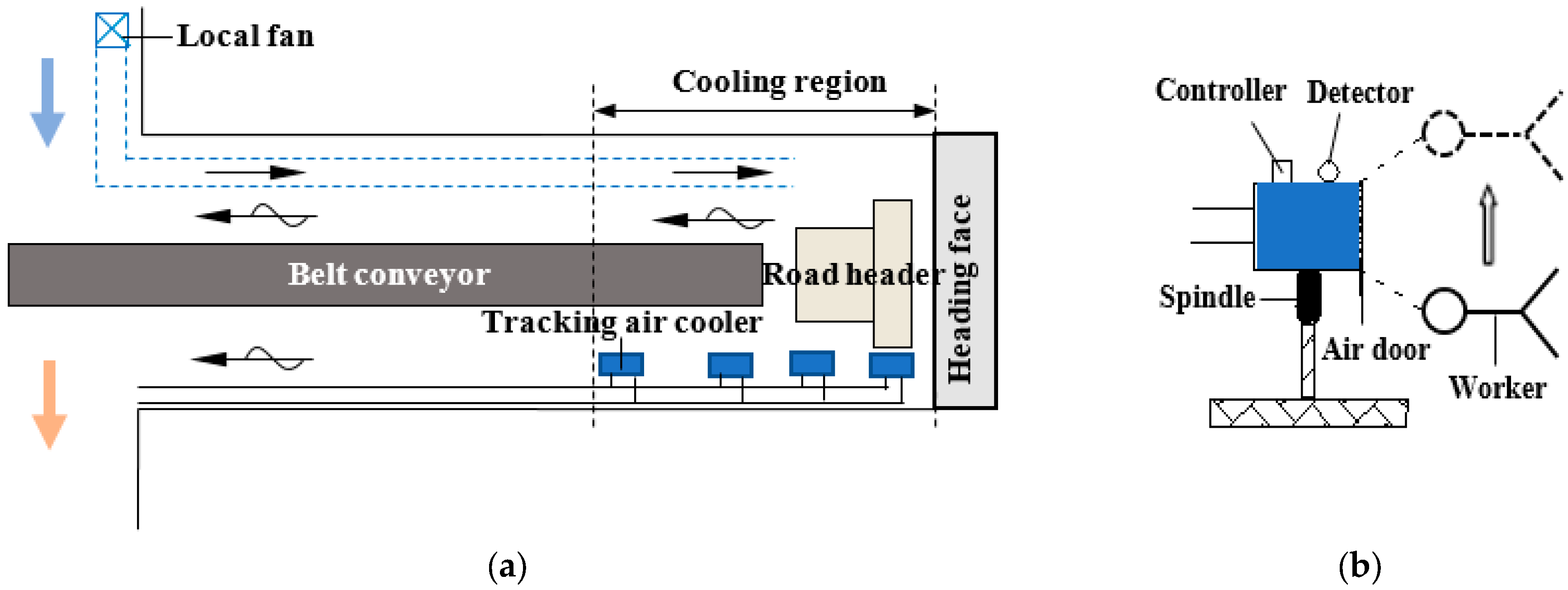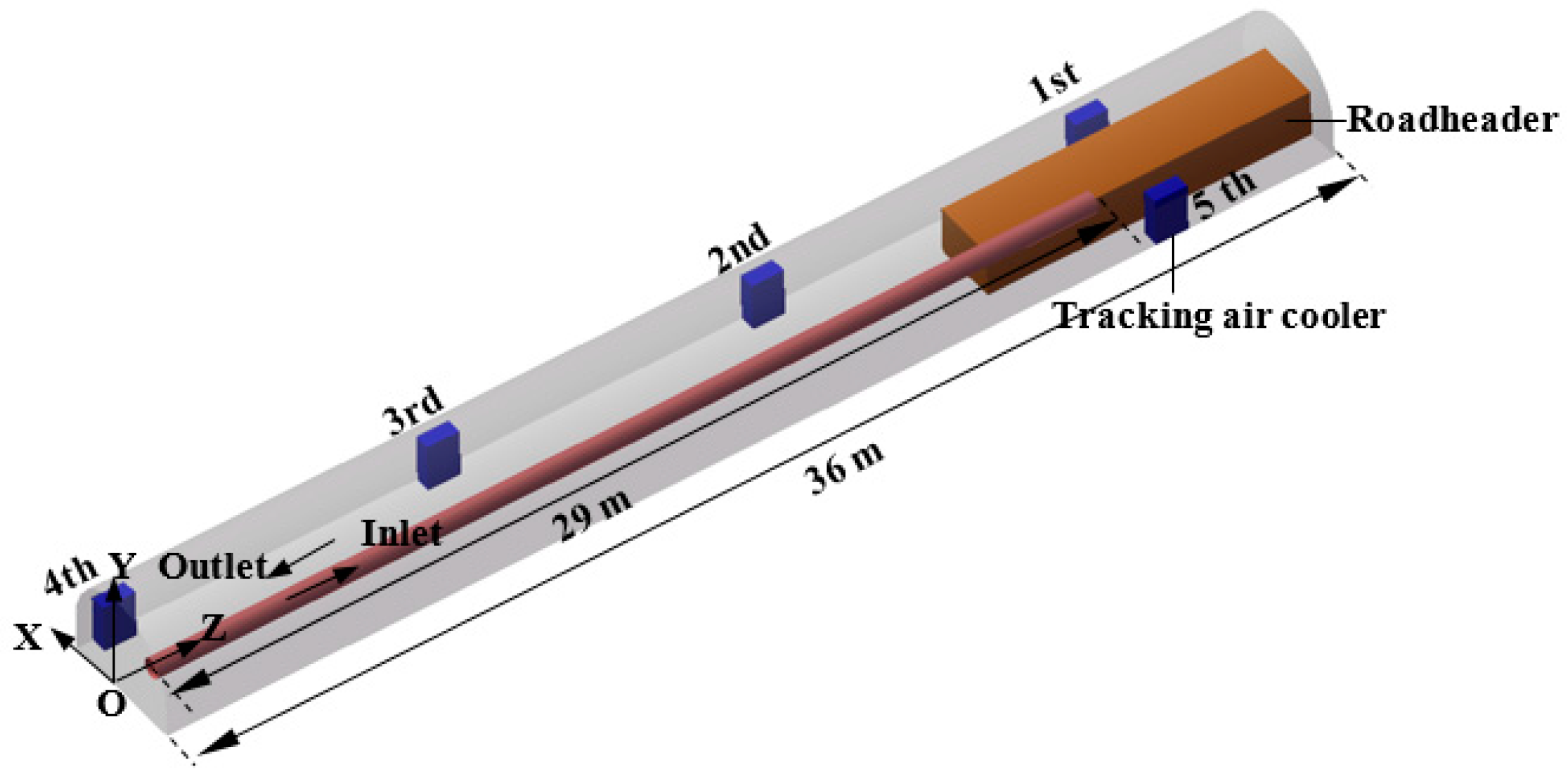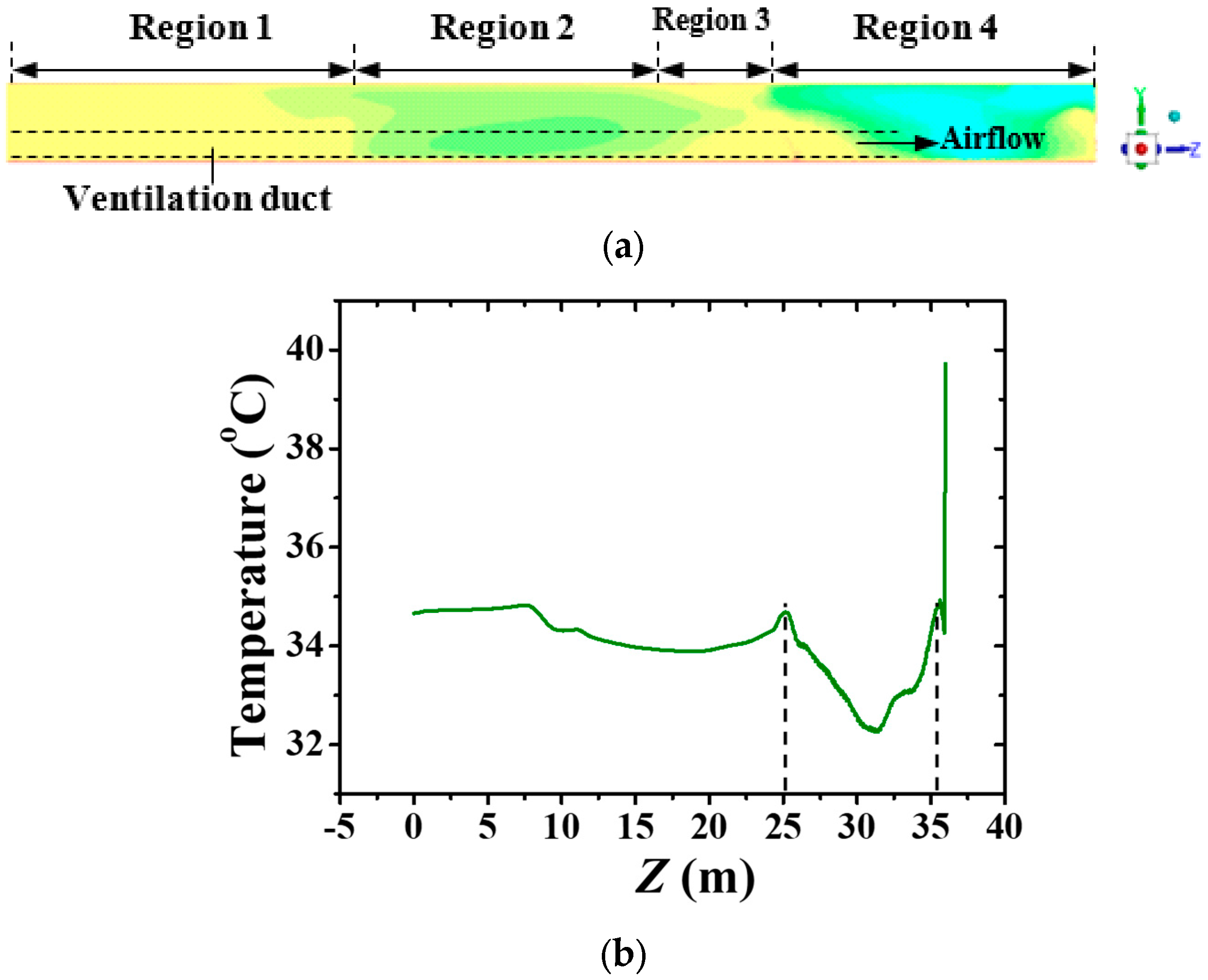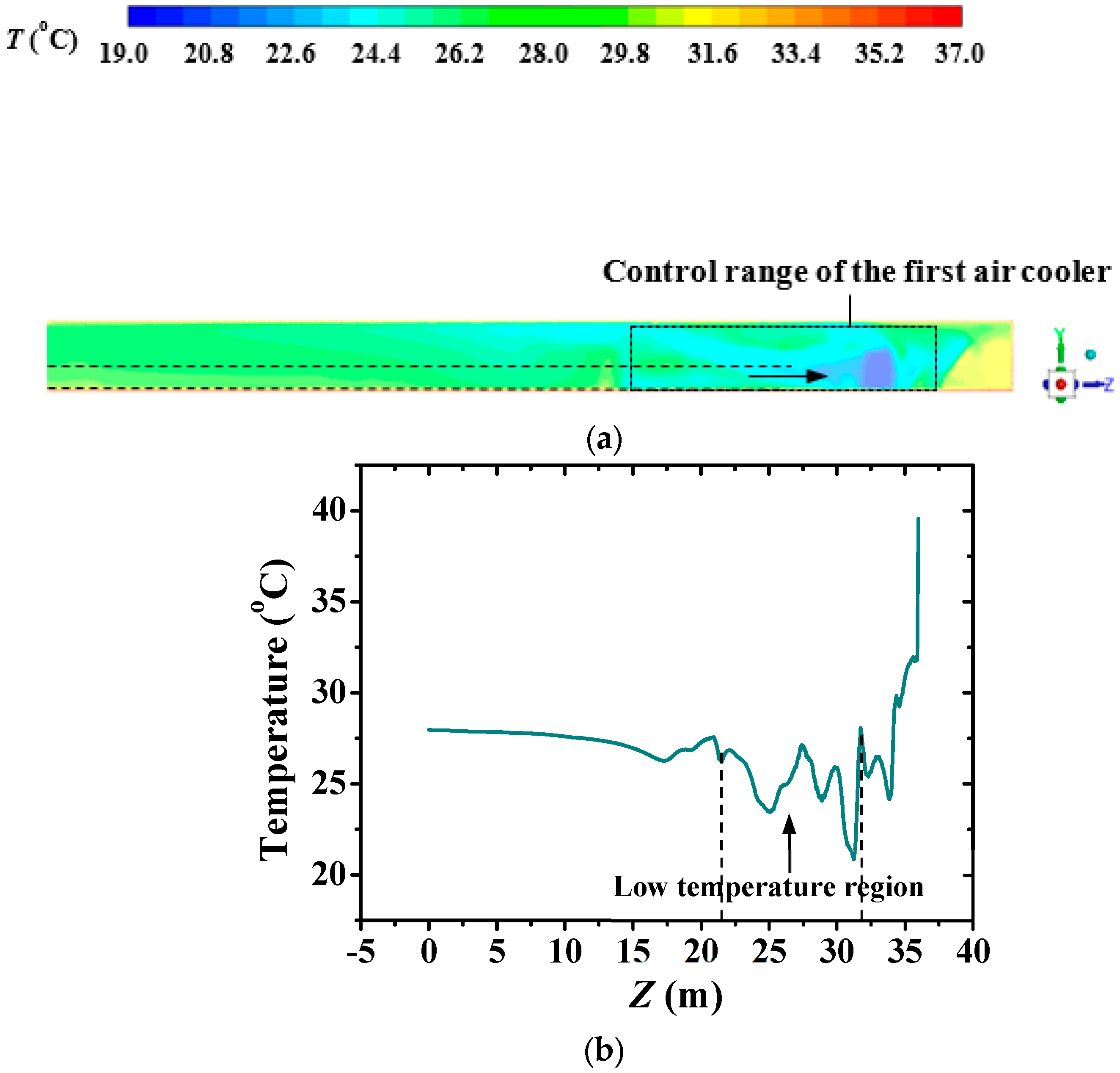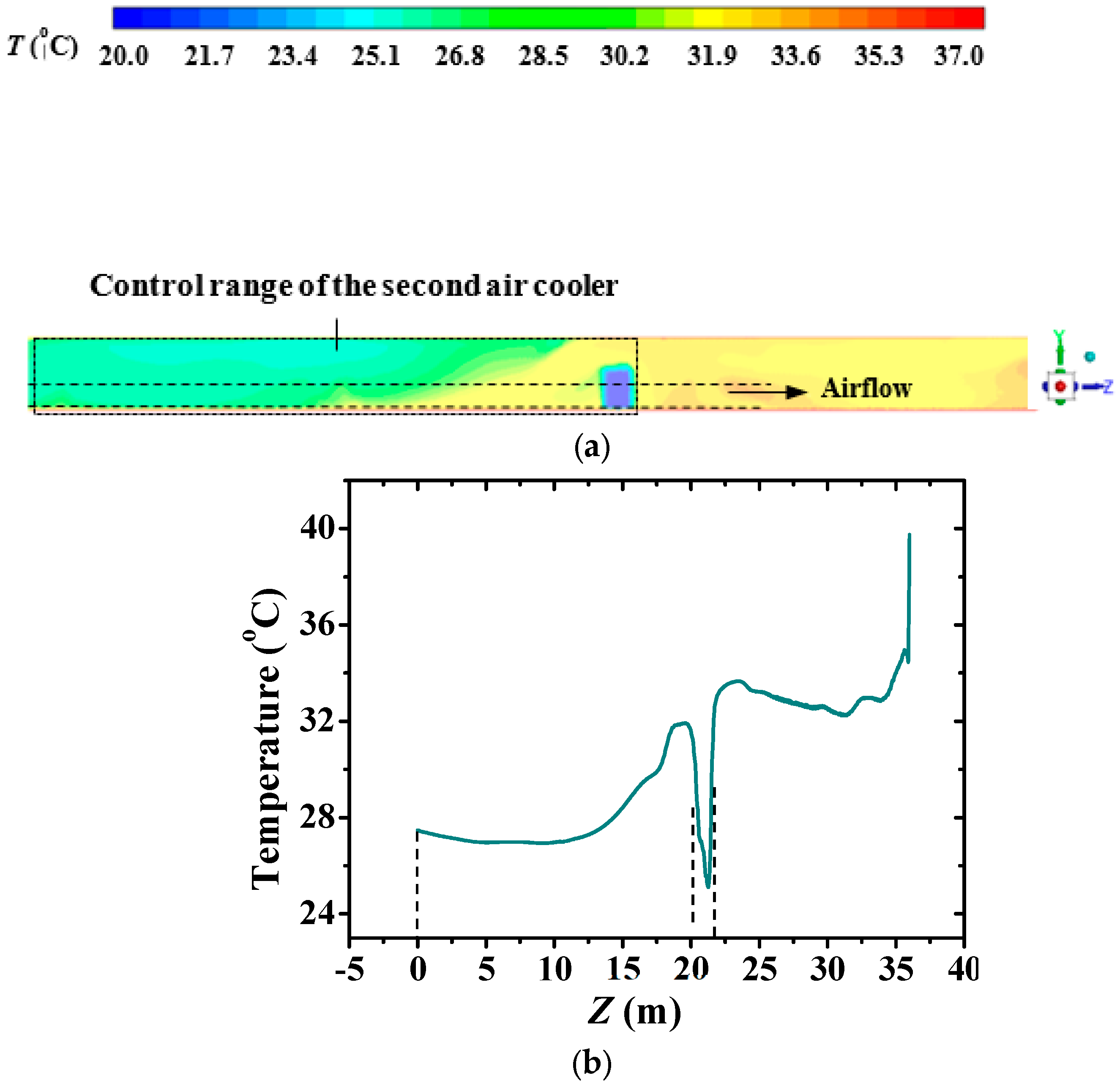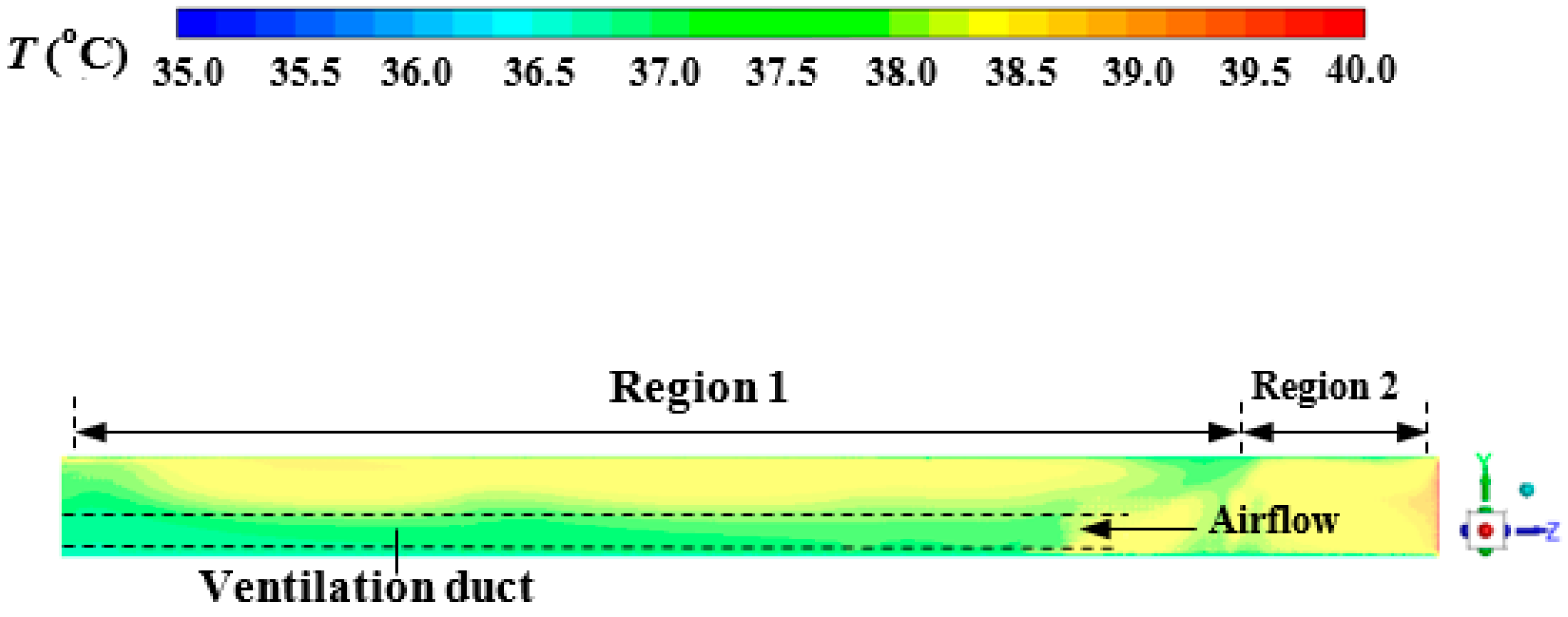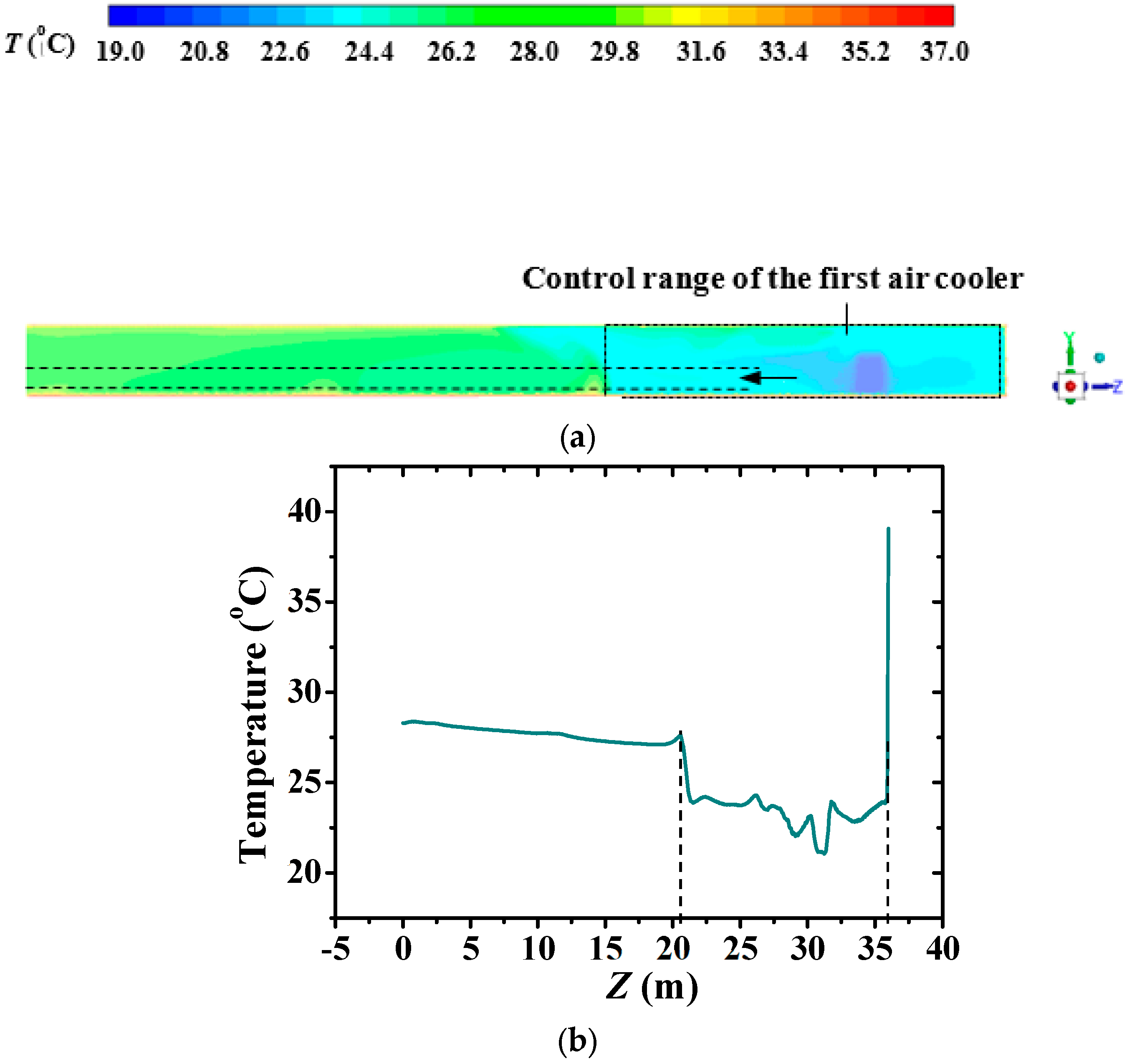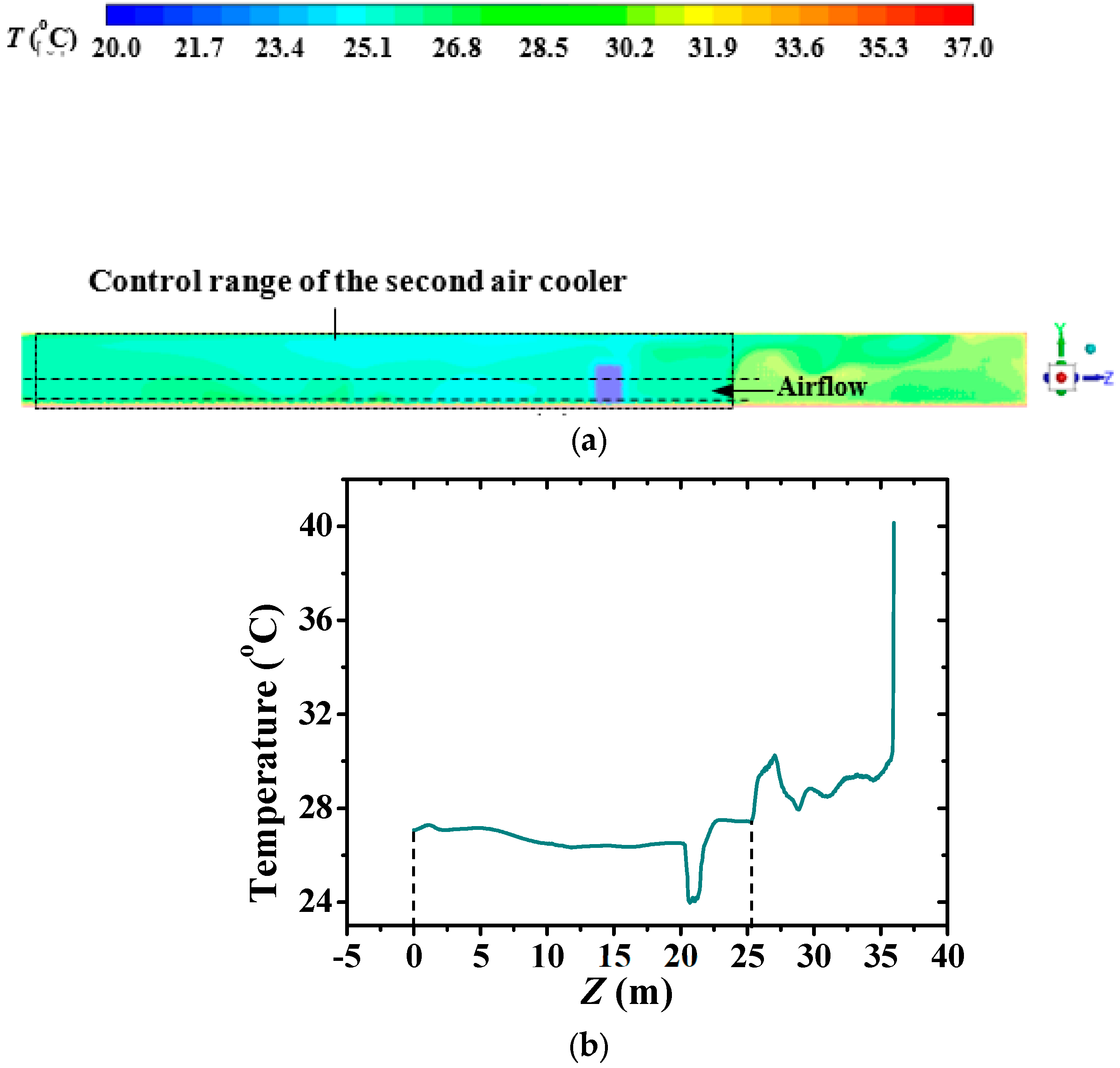1. Introduction
Fossil-fuel energy, which accounts for 87% of the market share, still dominates as the leading role of the world’s energy consumption structure [
1]. Among all kinds of fossil-fuel energy, coal consumption is the fastest growing [
2,
3,
4]. With the over-exploitation of mines, the mining depth continuously increases [
5]. The virgin rock temperature rises with mining depth [
6]. The heat of the surrounding rocks is transferred to the airflow because of the large temperature difference between them, and the thermal environment of the mines continues to deteriorate [
7,
8,
9]. Heat damage then inevitably occurs. Continuous high temperature can cause adverse health effects [
10]. Health symptoms of heat damage include but are not limited to fervescence, heatstroke, and nervous system disease [
11,
12,
13]. The labor productivity of the workers decreases, while the accident rate increases [
14,
15]. To improve the thermal environment and ensure personnel life and health safety, mine cooling is necessary.
The main methods to solve heat damage in mines include non-artificial refrigeration and artificial refrigeration [
16,
17]. Ventilation is the most common cooling method for non-artificial refrigeration. Other cooling measures, such as control of heat sources and individual protection, are supplemented to obtain a better cooling effect. However, when the heat damage is serious enough, ventilation cannot significantly lower the airflow temperature, and artificial refrigeration should be adopted [
18]. Artificial refrigeration, which is also called mechanical refrigeration, is a process by which heat is removed from a location using an artificial heat exchange system [
19,
20,
21]. The mechanical refrigeration system mainly comprises a refrigeration unit, a pipeline for cold transmission, and a terminal air conditioning unit [
22,
23]. The air cooler is one of the most common terminal units in the mine, whose layout and operating parameters can significantly affect the cooling effect of the mechanical refrigeration system. The air cooler comprises a fan and a heat exchanger. The fan forces air through the cooling coils of the heat exchanger. The airflow is cooled because of the heat exchange between the airflow and the cooling coils. The cold airflow is then blown to the roadway. The cooling load for a typical deep mine can reach up to 7000 kW [
20]. Generally, a typical mine contains numerous high-temperature working faces and heading faces for cooling.
The heading face is one of the most serious operation points of heat damage in mines [
24]. A heading face is a roadway that is first exploited in preparation for the mining face. Heat in the heading face is mainly produced from the surrounding rock, mechanical and electrical equipment, water flow, oxidation of coal, and blasting. As the heading face is a single end tunnel, it is difficult to release heat from the above heat sources to the external environment, and the temperature of the heading face is quite high.
Generally, the ventilation modes for the excavation roadway can be classified into two types: Forced ventilation and exhaust ventilation. Taking the forced ventilation as an example, there are two schemes for cooling the heading face, as shown in
Figure 1 [
25]. The first cooling scheme involves an air cooler installed after the local fan in the roadway. Then, the cold airflow is transported by a heat insulation duct to the heading face for a long distance [
26]. However, when the cold airflow arrives at the heading face, the airflow temperature has significantly increased due to violent heat exchange between the airflow and heat sources. To obtain a better cooling effect, the second cooling scheme is developed. A quantity of small air coolers are laid out in the heading face. As the transport distance of the cold airflow is much lower than that of the first cooling scheme, less cold loss is produced for this cooling scheme. However, for both the above two cooling schemes, the phenomenon of “back heating” occurs in the long-distance tunneling roadway. The temperature in the heading face is lower, while those in the middle and posterior region of the roadway are much higher. To ensure a fine thermal environment for all the workers, more energy must be consumed. Previous studies showed that more than a quarter of the energy for mining was consumed by the mine cooling [
1,
27].
The above studies show that the aim of the present cooling schemes is to cool the whole heading face. However, the workers therein only occupy a small area of the face, and a large quantity of energy is wasted. Unfortunately, none of the existing studies have reported a highly effective cooling scheme for the workers. To save energy and improve the thermal environment for the workers, a new cooling strategy for building a non-uniform environment was developed in this study. This cooling strategy cooled the space occupied by workers and ignored the ineffective space. A well-designed air cooler tracks the constantly moving workers and improves their thermal environment. The cooling load for this strategy was calculated and economic analysis was conducted. The airflow in the excavation roadway was numerically solved to estimate the cooling effect of this new cooling strategy.
3. Numerical Simulation of Airflow for the New Cooling Strategy
3.1. Physical Model
In this section, the airflow in the cooling region of the excavation roadway was simulated to estimate the cooling effect for the new cooling strategy. Two ventilation types, i.e., forced ventilation and exhaust ventilation, were considered. This study only simulated the case when the person was facing the tracking air cooler. For the sake of simplification, the following assumptions were adopted:
- (a)
The airflow is regarded as an incompressible fluid, and the dissipative heat caused by work of the viscous force of the fluid is neglected;
- (b)
The thermal environment of the roadway is in equilibrium;
- (c)
The influence of the conveyor, hydraulic support, and irregularity of the roadway on the flow field is neglected;
- (d)
The airflow is fully turbulent and satisfies the Boussinesq hypothesis.
Figure 4 shows the physical model with the forced ventilation based on an actual heading face. The length of a typical excavation roadway was greater than 1 km, while the dimensions of the cross-section of the roadway were only several meters. It was difficult to provide the whole heat profile. On the other hand, for the long-distance excavation roadway, most workers were located near the heading face. Thus, the cooling region was in front of the roadway. In this study, only the airflow in cooling region was simulated. The dimensions of the cooling region for the excavation roadway were 36 m × 4 m × 3.1 m. A ventilation duct with a diameter of 0.6 m was hung at a height of 1.9 m from the bottom of the roadway, which was 0.6 m away from the side wall. The length of the ventilation duct was 29 m. The dimensions of the roadheader and the tracking air cooler were 10 m × 2 m × 1.5 m and 1 m × 0.5 m × 1.5 m, respectively. Four tracking air coolers were equidistantly distributed on one side of the roadway to improve the thermal environment for the workers in the cooling region. As the roadheader stopped the cold airflow, another air cooler was installed on the other side of the roadway. Thus, there were five tracking air coolers distributed in the roadway. The distance between two neighboring air coolers was 10 m. For simplicity, other electromechanical equipment was not considered.
The ANSYS ICEM CFD software (Version 18.0.0; ANSYS Corp., USA) was used to create the mesh. Approximately 1.1 × 105 tetrahedral grid cells were generated. Three different quantities of grids, i.e., 1.5 × 106, 3.0 × 106, and 6.0 × 106, were adopted to conduct grid-independence analysis. The results showed that there were only slight differences in the airflow temperature between the three quantities of grid cells, and the deviation was less 10%. Therefore, we concluded that the mesh with the quantity of 3.0 × 106 was enough for the numerical investigation.
In the heading face, the mass, momentum, and energy transport for the airflow proceed all the time. The turbulence model is a key component for simulating the flow in the excavation roadway. The previous study showed that the simulation values for the standard
k–
ε model were closest to the experimental data [
30]. Thus, the standard
k–
ε model was chosen in this study. The inlet of the duct and the outlet of the roadway were set as the velocity-inlet and outflow, respectively. The solid walls were treated as a no-slip condition for flow. The wind duct was considered as the thermal insulation material. The boundary conditions of temperature and air speed are summarized in
Table 1.
The geometry and boundary conditions were solved by a commercial computational fluid mechanics software program, Fluent (Version 18.0.0; ANSYS Corp., USA). The equations were coupled by the Semi-Implicit Pressure-Linked Equation (SIMPLE) algorithm. When the relative residuals reached 1.0−6, the equations were considered as convergence. Each simulation required approximately 7500 iterations.
3.2. Temperature Distribution of the Airflow in the Heading Face
To estimate the cooling effect of the new cooling strategy, the airflow temperature cooled only by ventilation was compared with that by the new cooling strategy.
Figure 5 shows the temperature distribution of airflow in the heading face cooled only by forced ventilation. The cooling region was divided into four sub regions. At the inlet of the cooling region (Region 1), the airflow temperature was quite high, and the value ranged from 34.5 °C to 35.0 °C (
Figure 5b). The temperature slightly decreased in Region 2, and the average value was 34.0 °C. For Region 3, because the roadheader released a great amount of heat to the airflow, the airflow temperature increased to 35.0 °C. The temperature value in Region 4 significantly decreased due to ventilation cooling, and the minimum value was 32.3 °C. Thus, ventilation cooling only cooled the region near the heading face to some extent. However, the temperature in the front and middle of the cooling region was still quite high. The above regions should be further cooled. This study only simulated the temperature distribution near the heading face. In the future, more dedication will be devoted to providing the heat profile for the whole excavation roadway.
Figure 6 presents the airflow temperature when the first tracking air cooler worked. The temperature ranged from 21 °C to 27 °C within the control range of 10 m, which decreased about 10 °C compared to that only by ventilation. Thus, the thermal environment for the workers significantly improved. To achieve highly effective cooling to the personnel in the heading face, the air cooler focused on the space occupied by the personnel and ignored the space not occupied by workers. Thus, the airflow temperature outside of the control range of the first air cooler (up to 30 °C) was much higher than that in the control range.
When the second air cooler worked, as shown in
Figure 7, the temperature in the posterior of the cooling region significantly decreased, with the temperature range from 25 °C to 30 °C. However, the temperature in the front of the cooling region near the heading face was higher. This might be because the second air cooler was further away from the outlet of the air duct than the first air cooler. The value of the temperature increased in front of the cooling region. The results showed that the thermal environment in the posterior of the cooling region was improved to some extent, and the temperature in front of the cooling region should be further decreased. Other tracking air coolers had similar results.
Figure 8 shows the temperature distribution of airflow in the heading face cooled only by exhaust ventilation. For simplification, the variation in temperature with the displacement was not presented. The cooling region was divided into two sub regions. For Region 1, the airflow temperature was layered vertically. The temperature value in the upper area was approximately 38.5 °C, which was slightly higher than that in the lower area (38.0 °C). The temperature distribution in Region 2 was more homogeneous compared to that in Region 1. The results showed that the airflow temperature with the exhaust ventilation was higher than that with the forced ventilation.
Figure 9 presents the airflow temperature when the first tracking air cooler worked with exhaust ventilation. The cooling effect of the new cooling strategy with exhaust ventilation was better than that with forced ventilation. The temperature in the vicinity of the heading face was approximately 25 °C, which was much lower than that for the forced ventilation (
Figure 6).
Figure 10 shows the temperature distribution when the second tracking air cooler worked with exhaust ventilation. The temperature value ranged from 24 °C to 27 °C within the control range of 15 m, which decreased about 3 °C compared to that by forced ventilation. The thermal environment in the leeward direction of the air cooler significantly improved.
4. Discussion
4.1. Main Findings of This Study
This research developed a new cooling strategy in the heading face. The tracking air cooler was designed to track the workers and build a non-uniform environment. The results showed that this cooling strategy had great energy saving potential and a fine cooling effect, particularly for the workers who were far from the heading face. There were a lot of cooling schemes; however, no study considered to cool the area occupied by the workers and ignored the invalid space. A great amount of energy was inevitably wasted, and a benign thermal environment for the workers could not be guaranteed. This study might improve energy and cooling efficiency.
The existing cooling strategies aim to cool the whole cooling region, while the new cooling strategy in this study changed the approach to build a non-homogeneous environment. As the purpose of refrigeration was to improve the thermal environment for the workers, the well-designed tracking air cooler could realize high-efficiency cooling. This new cooling strategy could be popularized in all of mine cooling.
4.2. Limitation of the Current Study and Outline of Future Research
According to the Coal Mine Safety Regulation in China, the temperature of the airflow in the cooling range should not be higher than 26 °C. Actually, the temperature value in the heading face for the deep mine was much higher than 26 °C, as shown in
Section 2.2. In this study, the temperature of the cooling region in the heading face was assumed to exceed the regulations of the Coal Mine Safety Regulation in China. Thus, once a person enters the control range of the tracking air cooler, the air door opens and then cold air is blown to the person. In addition, thermal hazards should be mitigated according to several complex indices [
31,
32]. In this study, only temperature was considered as an indicator to estimate the cooling effect of the new cooling strategy.
To realize high-efficiency cooling, the design and layout mode of the tracking air cooler were the important part. In the heading face, the space was limited, and the air coolers that were laid out therein might cause congestion. The environmental conditions of the heading face were poor. A great amount of dust could be produced when headwork was being performed. Once the dust particles adhered to the surface of the coil of the air cooler, the heat exchange performance significantly decreased. In addition, the heading face and workers were continually moving forward. To guarantee a benign thermal environment, the tracking air coolers should also move with the heading face. This study only provided a new cooling strategy and designed the rudiments of the tracking air cooler. In future studies, the actual manufacture and air distribution of the tracking air cooler should be further investigated.
In the current stage, we concentrated only on the efficient cooling in the heading face of underground mines. However, gas (methane and carbon dioxide) might be released from the surrounding rock to the heading face during the carbonification process. The local airflow from the tracking air cooler could keep the gas in the heading face, and the gas might accumulate there. In the future, more dedication will be devoted to evaluating impacts of the local airflow on the gas accumulation in the heading face.

